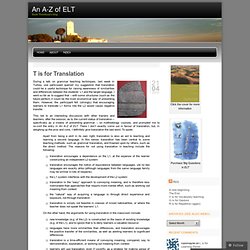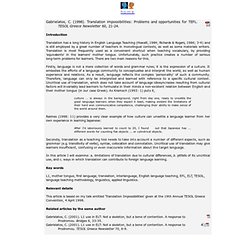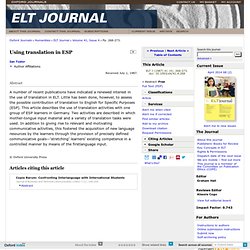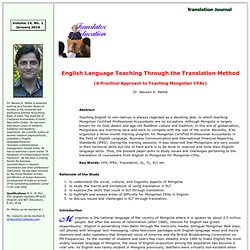

T is for Translation. During a talk on grammar teaching techniques, last week in Turkey, one participant queried my suggestion that translation could be a useful technique for raising awareness of similarities and differences between the students’ L1 and the target language.

I went so far as to suggest that – with some structures (such as the future perfect) it could be the most economical way of presenting them. However, the participant felt (strongly) that encouraging learners to translate L1 forms into the L2 would cause negative transfer. This led to an interesting discussion with other trainers and teachers, after the session, as to the current status of translation – specifically as a means of presenting grammar – on methodology courses, and prompted me to re-visit the entry in An A-Z of ELT.
There I don’t exactly come out in favour of translation, but, in weighing up the pros and cons, I definitely give translation the last word. To quote: Translation impossibilities: Problems and opportunities for TEFL-Mozilla Firefox. Introduction Translation has a long history in English Language Teaching (Howatt, 1984; Richards & Rogers, 1986; 3-4) and is still employed by a great number of teachers in monolingual contexts, as well as some materials writers.

Translation is most frequently used as a convenient shortcut when teaching vocabulary, by providing 'equivalents' in the learners' mother tongue. Unfortunately, such practice creates a number of serious long-term problems for learners. There are two main reasons for this. Firstly, language is not a mere collection of words and grammar rules; it is the expression of a culture. Culture ... is always in the background, right from day one, ready to unsettle the good language learners when they expect it least, making evident the limitations of their hard won communicative competence, challenging their ability to make sense of the world around them. Translation in ELT - Maurice Claypole-Mozilla Firefox. Using translation in ESP-Mozilla Firefox. Ian Tudor + Author Affiliations Received July 1, 1987.

A number of recent publications have indicated a renewed interest in the use of translation in ELT. Little has been done, however, to assess the possible contribution of translation to English for Specific Purposes (ESP). This article describes the use of translation activities with one group of ESP learners in Germany. . © Oxford University Press. Translation activities in the language classroom. It does not consider the role of the L1 as a teaching tool, for example for classroom management, setting up activities, or for explaining new vocabulary.

This question has been discussed elsewhere on the Teaching English site. The article starts by looking at what we mean by translation as an activity in the language classroom, and then briefly reviews the history of translation in language learning within the framework of various methodologies. It then considers some of the many objections ELT thinkers and practitioners have had to translation, and some of the possible benefits of its use. It concludes with some observations about how to make translation tasks successful, and some activities. Introduction Translation was a significant part of ELT for a long time, and then a significant missing part for a long time also.
Objections to using translation We can consider possible problems with using translation by looking at possible negative impact on learners and then on teachers. Translation: the fearful phantom of ELT. In modern times there is hardly any English language teacher that does not have a special attitude to translation.

It’s usually a love or hate relationship, nothing between. You either love it, or hate it and this determines your teaching practice. I believe this phantom likes haunting in its ‘geographical preferences’: EFL contexts, where translation has been a dominant technique to learn a foreign language for times immemorial. However, globalization and voluntary or imposed policy borrowing have changed this context to the extent of some teachers totally banishing translation from their practice and some others, in contrast, frantically adhering to it as a saviour of ‘real knowledge’. So, the big question for many practitioners still remains this: translate or not translate? I believe that you can either befriend any phantom or go on shunning it like a plague, which, however, does not prevent you from the inevitable encounter. Consulting a monolingual dictionary is a must. TESOL Quarterly, Vol. 33, No. 2 (Summer, 1999), pp. 185-209-Mozilla Firefox. English Language Teaching Through the Translation Method-Mozilla Firefox.
Rationale of the Study to understand the social, cultural, and linguistic aspects of Mongolia. to study the merits and limitations of using translation in ELT. to explore the skills that count in ELT through translation. to highlight and assess areas of difficulty for Mongolian CPAs in English.

To discuss issues and challenges in ELT through translation. Introduction ongolian is the national language of the country of Mongolia where it is spoken by about 2.5 million people. But after the waves of reformation (after 1990), interest for English has grown stupendously. Review of Literature Ortega Y Gasset (1945) defines translation as an "utopian operation.
"